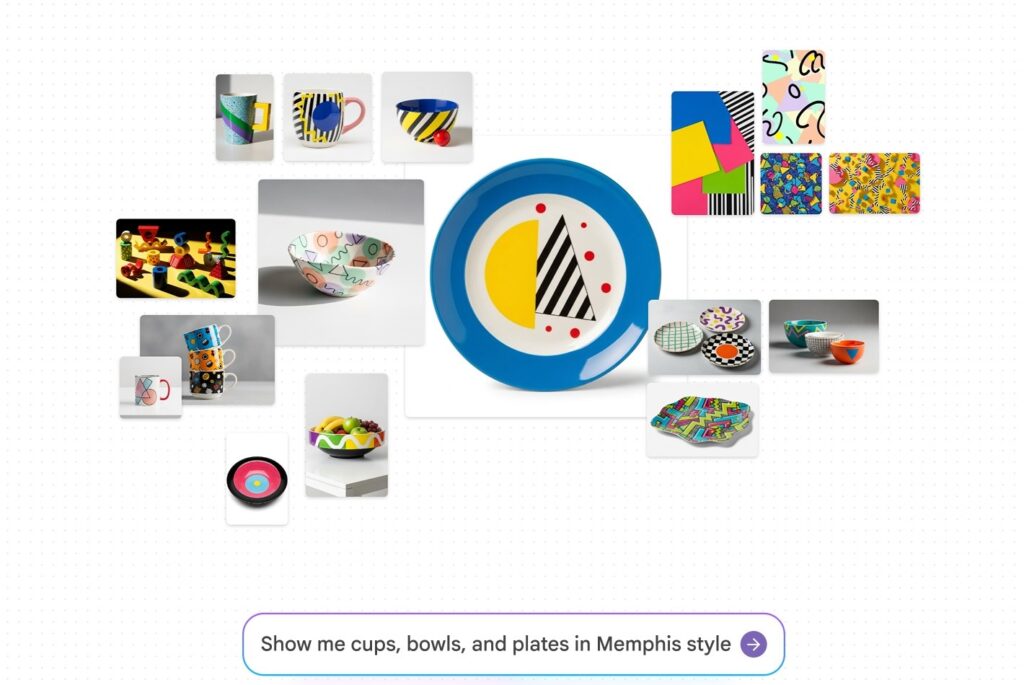Google’s latest Labs experiment, Mixboard, is basically Pinterest with a prompt bar—and I mean that as a compliment. It’s an AI-powered moodboard canvas that lets you conjure visual directions from a blank page (or a template) using simple text prompts via Gemini 2.5 Flash Image. Think “show me cups, bowls, and plates in Memphis style” or “plan an autumn party in my living room,” and it’ll spit out a board of generated images you can shuffle, remix, and refine with natural language. You can also upload your own references and tell it to riff. It’s in public beta in the US starting now.
If you’ve used FigJam, Milanote, Miro, Pinterest, or Adobe’s new Firefly Boards, you know the vibe: open canvas, drop assets, arrange, annotate, iterate. Mixboard sits right in that lane—except Google’s angle is to make the “what the hell should this even look like?” phase faster with generative visuals on tap. One-click controls regenerate or create lookalikes, and prompts can tweak composition or fuse elements across the board. It’s concepting as a feedback loop instead of a scavenger hunt.
Is this original? Not really. But it is timely. Design teams, brand folks, interior planners, even party planners spend ungodly amounts of time churning references, building mood stacks, and begging the internet for that one image that nails the tone. Pinterest has over 500 million monthly users for a reason. The ideation layer is where modern creative work starts, and it’s also where it’s easiest to waste hours. Mixboard’s pitch is speed + coherence: get to a shared visual language faster, then debate refinements instead of arguing about vibes.
The magic trick here is how much control Google can make feel natural without forcing you into prompt poetry.
Here is some of what you can do:
- Prompt whole boards from scratch or start with templates.
- Upload references and ask it to “make more like this,” i.e., image-to-image.
- Combine and adjust elements with plain English (“merge the top-left pattern with the color palette from slide three,” etc.).
- Rapid-fire regenerate or spawn siblings when you’re close but not quite there.
That last bit matters. A lot of AI image tools are great for one-off hero shots. Moodboards need breadth: variations across palette, shape, texture, and composition. If Mixboard nails fast iterative breadth, it becomes more than a toy.
Of course, this is Google Labs, which means the usual “will they keep it alive longer than a succulent” suspicion is warranted. The company has a long, storied history of inventing decent ideas and then punting them into the Google Graveyard the moment an SVP gets bored. If Mixboard doesn’t get tied into Google Drive, Docs, or Slides—or a Gemini Workspace tier—it risks being fun for a weekend and forgotten by next quarter. The stickiness comes from collaboration, comments, permissions, and export paths into the tools people actually ship with.
As far as tools, Mixboard lands in a busy neighborhood:
- Adobe’s Firefly Boards does near-identical moodboard + gen flows and can sit right next to Photoshop and Illustrator in pro pipelines.
- Figma has been quietly threading AI through FigJam and is the de facto home for product design collaboration.
- Canva already owns the casual-to-pro, “I need it now” audience at massive scale.
So why Mixboard? Two reasons. One, Gemini 2.5 Flash Image is built for low latency. If Google can keep generations sub-quick while offering decent style control, that’s addictive. Two, Google can surface this everywhere—Search side panels, Workspace, Android share sheets, Chrome sidebars—if it wants to. In this context, ubiquity beats novelty.
There are caveats. Image fidelity and style control will define whether designers trust this for client-facing work, or just use it to lubricate early thinking. If you can’t pin color systems, typography vibes, material finishes, or camera language tightly, you’re back in chaos-land. Safety and licensing also matter. Generative platforms have steadily moved toward clearer commercial-use terms and better provenance tools, but teams will still ask: Can we use this in a deck? Can we sell this concept? Does it watermark? Will our uploads get sucked into model training? If you’re pitching enterprise, those aren’t nice-to-haves.
And then there’s the cultural question: are we okay with AI moodboards? For a lot of creatives, the hunt is part of the craft—the act of taste selection via references pulled from real artifacts, photographers, and studios. Auto-generating a “vibe” can feel like skipping leg day. On the other hand, no one gets a medal for spending four hours combing Pinterest for a terracotta-and-brass dining set that only exists in your head. If a model can approximate it and get the team aligned on a direction in 10 minutes, that’s a pragmatic win. You still have to execute. You still need taste.
Best-case scenario, Mixboard becomes a fast pre-visualizer: generate roughs, pin down a look, then replace the AI placeholders with actual references or commissioned work as you move past mood into design. Worst case, it’s another Labs curiosity that never clears the “cute demo” bar and quietly disappears while Adobe and Figma keep harvesting workflows.
What to watch next:
Collaboration: shared boards, comments, cursors, and version history are table stakes for teams.
Integrations: Drive/Docs/Slides exports, Figma/Adobe plugins, and an API would make this feel real.
Controls: palette locking, layout grids, brand kits, and reference-weight sliders would make designers trust it.
Rights/Policy: explicit commercial-use terms and clear toggles for training on user uploads.
For now, Mixboard is a clean, clever swing at the messy front end of creativity. It’s not trying to design your product or your living room for you; it’s trying to get everyone to agree on the target look faster, without fifteen tabs and a migraine. If Google treats it like a feature of a bigger ecosystem rather than a quirky standalone, it could stick. If not, well—enjoy your weekend playing moodboard necromancy while it lasts.



No Comments